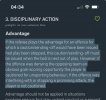Question from a grassroot level new Referee:
Is there a sanction for a player who pushes an attacker on a breakaway the defender is hot on his heels, at the last possible moment the defender leans out and pushes the attacker in the back while in the penalty area the attacker keeps their balance long enough to get a shot off and score the goal?
Is there a sanction for a player who pushes an attacker on a breakaway the defender is hot on his heels, at the last possible moment the defender leans out and pushes the attacker in the back while in the penalty area the attacker keeps their balance long enough to get a shot off and score the goal?



